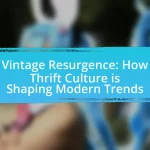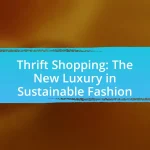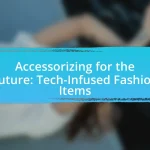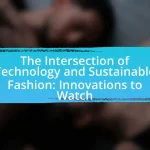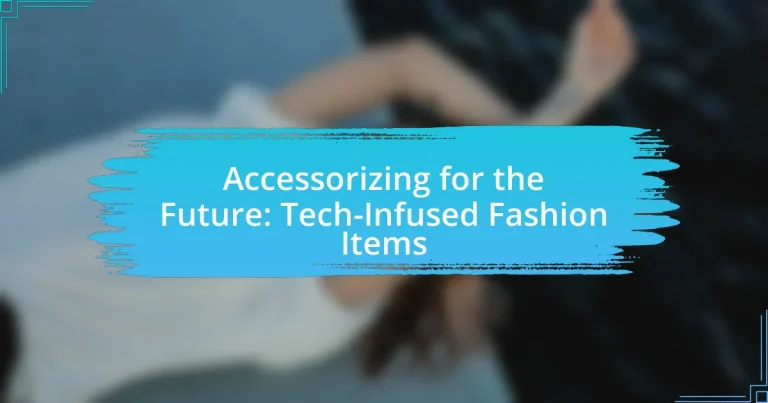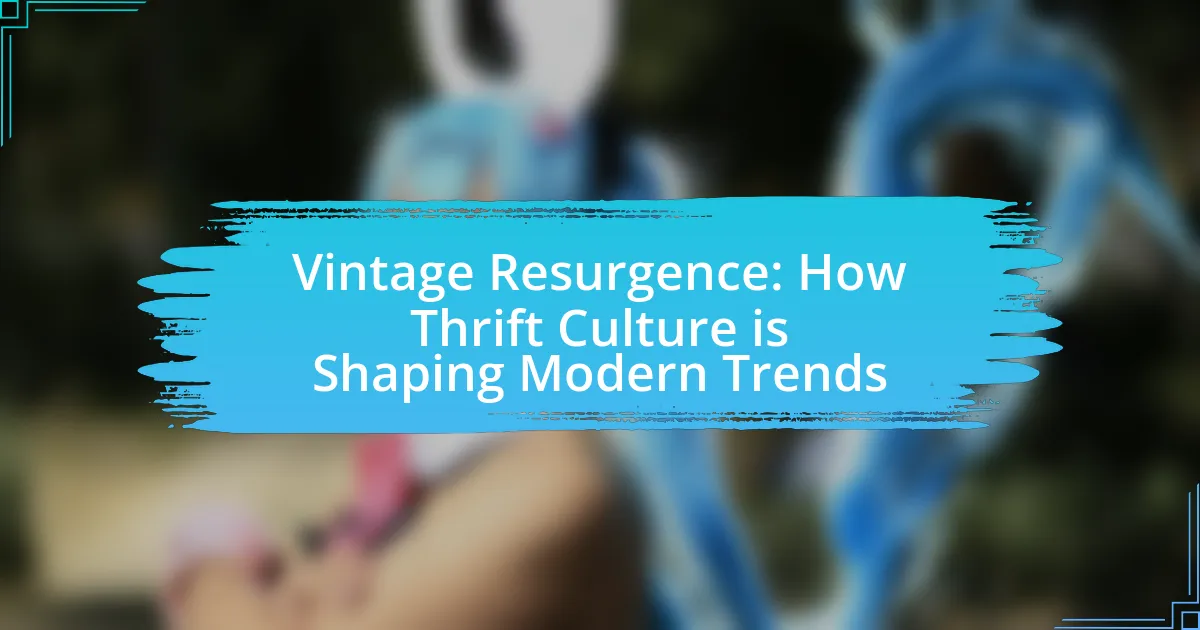Tech-infused fashion items represent a convergence of technology and style, incorporating features such as health monitoring, connectivity, and augmented reality into clothing and accessories. This article explores the distinctions between tech-infused items and traditional accessories, highlighting the technologies involved, their functionalities, and the growing consumer demand for such innovations. It also addresses potential drawbacks, including privacy concerns and maintenance issues, while examining the influence of social media and consumer preferences on this trend. Additionally, the article provides guidance on selecting and integrating these items into daily life, emphasizing the importance of balancing functionality with personal style.

What are Tech-Infused Fashion Items?
Tech-infused fashion items are clothing and accessories that integrate technology to enhance functionality, aesthetics, or user experience. Examples include smartwatches that track health metrics, clothing with built-in sensors for temperature regulation, and augmented reality glasses that overlay digital information onto the real world. These items often utilize materials like conductive fabrics and embedded electronics, showcasing a blend of fashion and innovation that caters to modern consumer needs.
How do tech-infused fashion items differ from traditional accessories?
Tech-infused fashion items differ from traditional accessories primarily through their integration of technology, enabling functionalities beyond mere aesthetics. While traditional accessories serve decorative purposes, tech-infused items often include features such as connectivity, interactivity, and data collection, exemplified by smartwatches that track health metrics or smart jewelry that can receive notifications. This technological integration enhances user experience and functionality, making these items not only fashion statements but also practical tools in daily life. For instance, the global market for smart wearables was valued at approximately $116 billion in 2021, indicating a significant shift towards technology-driven fashion.
What technologies are commonly integrated into fashion items?
Technologies commonly integrated into fashion items include smart textiles, wearable electronics, and augmented reality features. Smart textiles, such as those embedded with sensors, can monitor health metrics like heart rate and temperature. Wearable electronics, including smartwatches and fitness trackers, provide connectivity and functionality, allowing users to receive notifications and track physical activity. Augmented reality features enhance the shopping experience by allowing customers to visualize how clothing will look on them through virtual fitting rooms. These integrations reflect the growing trend of merging technology with fashion to enhance functionality and user experience.
How do these technologies enhance functionality?
Technologies enhance functionality in tech-infused fashion items by integrating smart features that improve user experience and utility. For instance, wearable technology such as smartwatches and fitness trackers provides real-time health monitoring, enabling users to track their physical activity, heart rate, and sleep patterns. This integration of technology into fashion not only adds convenience but also promotes a healthier lifestyle, as evidenced by a study from the Journal of Medical Internet Research, which found that users of fitness trackers increased their physical activity levels by an average of 30%. Additionally, smart fabrics can regulate temperature and moisture, enhancing comfort and performance in various environments. These advancements demonstrate how technology can transform traditional fashion items into multifunctional tools that cater to modern needs.
Why is the trend of tech-infused fashion items gaining popularity?
The trend of tech-infused fashion items is gaining popularity due to the increasing consumer demand for functionality and personalization in clothing and accessories. As technology advances, consumers seek products that not only enhance their style but also offer practical benefits, such as health monitoring and connectivity. For instance, the global smart clothing market is projected to reach $5.4 billion by 2024, indicating a significant shift towards integrating technology into everyday wear. This trend is further fueled by the rise of wearable technology, with devices like smartwatches and fitness trackers becoming mainstream, leading consumers to expect similar innovations in fashion.
What consumer needs are being addressed by these items?
Tech-infused fashion items address consumer needs for functionality, style, and connectivity. These items combine aesthetic appeal with practical features, such as health monitoring, enhanced communication, and convenience. For instance, smartwatches not only serve as fashion accessories but also track fitness metrics and receive notifications, fulfilling the need for both personal expression and technological integration in daily life. Additionally, the rise of sustainable tech-infused materials meets the growing consumer demand for environmentally conscious products, aligning with values of sustainability and ethical consumption.
How do social media and influencers impact this trend?
Social media and influencers significantly drive the trend of tech-infused fashion items by shaping consumer perceptions and preferences. Influencers showcase these innovative accessories to their followers, creating a sense of desirability and urgency. For instance, a study by the Digital Marketing Institute found that 49% of consumers rely on influencer recommendations for their purchasing decisions, highlighting the persuasive power of social media in promoting tech-infused fashion. Additionally, platforms like Instagram and TikTok facilitate visual storytelling, allowing influencers to demonstrate the functionality and style of these items, further enhancing their appeal.
What are the potential drawbacks of tech-infused fashion items?
Tech-infused fashion items can present several potential drawbacks, including high costs, technical malfunctions, and privacy concerns. The integration of technology into clothing often results in elevated prices due to the advanced materials and components used, making them less accessible to a broader audience. Additionally, these items may experience technical issues, such as software glitches or battery failures, which can diminish their functionality and user experience. Furthermore, the incorporation of technology raises significant privacy concerns, as wearable devices can collect personal data, leading to potential misuse or unauthorized access. These drawbacks highlight the challenges associated with the adoption of tech-infused fashion items.
What concerns do consumers have regarding privacy and data security?
Consumers are primarily concerned about unauthorized access to their personal data and the potential misuse of that information. This concern is heightened by the increasing integration of technology in fashion items, which often collect sensitive data such as location, health metrics, and personal preferences. A survey conducted by the Pew Research Center in 2021 found that 79% of Americans are concerned about how companies use their personal data, indicating a widespread apprehension regarding data security. Additionally, incidents of data breaches and identity theft have further fueled these concerns, as consumers fear that their information could be exploited for fraudulent activities.
How do maintenance and durability issues affect user experience?
Maintenance and durability issues significantly detract from user experience by leading to increased frustration and decreased satisfaction with tech-infused fashion items. When these items require frequent repairs or replacements, users face interruptions in their daily lives and may feel that the products do not meet their expectations for quality and longevity. Research indicates that 70% of consumers consider durability a critical factor in their purchasing decisions, highlighting the importance of reliable performance in enhancing user satisfaction. Furthermore, products that are difficult to maintain can result in negative perceptions of the brand, as users may associate poor durability with low quality, ultimately affecting brand loyalty and repeat purchases.
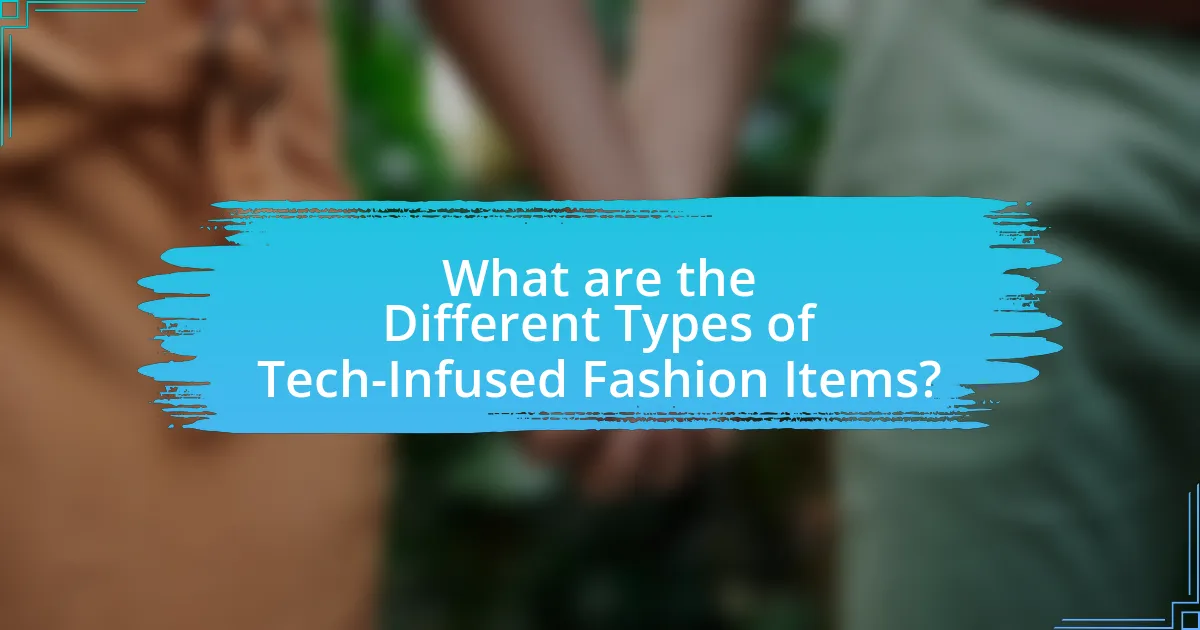
What are the Different Types of Tech-Infused Fashion Items?
Tech-infused fashion items include smart clothing, wearable technology, and augmented reality accessories. Smart clothing integrates sensors and electronics to monitor health metrics, such as heart rate and temperature, while wearable technology encompasses devices like smartwatches and fitness trackers that provide notifications and activity tracking. Augmented reality accessories, such as smart glasses, overlay digital information onto the real world, enhancing user experience. These categories reflect the growing intersection of technology and fashion, driven by advancements in materials and consumer demand for multifunctional apparel.
What categories of tech-infused accessories are available?
Tech-infused accessories are available in several categories, including wearable technology, smart jewelry, smart bags, and augmented reality devices. Wearable technology encompasses items like smartwatches and fitness trackers that monitor health metrics. Smart jewelry includes rings and bracelets that provide notifications or health tracking. Smart bags often feature charging capabilities and integrated technology for convenience. Augmented reality devices, such as smart glasses, enhance user experiences by overlaying digital information onto the real world. These categories reflect the integration of technology into everyday accessories, enhancing functionality and user experience.
How do smartwatches compare to traditional watches?
Smartwatches offer advanced functionalities compared to traditional watches, primarily through features like fitness tracking, notifications, and app integration. Traditional watches focus on timekeeping and aesthetic appeal, often serving as status symbols or fashion accessories. In contrast, smartwatches can monitor heart rate, track steps, and provide real-time updates from smartphones, reflecting a shift towards multifunctional devices in personal accessories. According to a report by IDC, global smartwatch shipments reached 100 million units in 2020, indicating a growing preference for tech-infused wearables over conventional timepieces.
What features distinguish smart clothing from regular apparel?
Smart clothing is distinguished from regular apparel by its integration of technology that enables functionalities such as health monitoring, temperature regulation, and connectivity. For instance, smart clothing often includes sensors that track biometric data like heart rate and activity levels, which regular apparel lacks. Additionally, smart fabrics can adapt to environmental conditions, providing features like moisture-wicking or temperature control, enhancing user comfort and performance. This technological integration is supported by research indicating that the global smart clothing market is projected to reach $5.3 billion by 2024, highlighting the growing demand for these innovative features in fashion.
How are wearable tech items evolving in the fashion industry?
Wearable tech items are evolving in the fashion industry by integrating advanced functionalities such as health monitoring, connectivity, and personalization into stylish designs. For instance, smartwatches now offer features like heart rate tracking and GPS navigation while maintaining aesthetic appeal, as seen in brands like Apple and Garmin, which have collaborated with fashion designers to create visually appealing models. Additionally, smart fabrics are being developed that can change color or pattern based on user preferences or environmental conditions, exemplified by companies like Wearable X, which combines fashion with technology to enhance user experience. This evolution reflects a growing consumer demand for products that blend functionality with style, leading to innovative collaborations between tech companies and fashion designers.
What innovations are being introduced in smart jewelry?
Innovations in smart jewelry include advanced health monitoring features, such as heart rate tracking, sleep analysis, and stress management, integrated into wearable designs. For instance, devices like the Oura Ring and smart bracelets from brands like Fitbit and Apple have incorporated sensors that provide real-time health data, enabling users to monitor their well-being seamlessly. Additionally, smart jewelry is increasingly utilizing materials like bio-compatible metals and sustainable resources, enhancing both functionality and environmental responsibility. These advancements reflect a growing trend towards merging technology with personal style, making smart jewelry not only fashionable but also a vital tool for health and wellness management.
How are augmented reality and virtual reality influencing fashion accessories?
Augmented reality (AR) and virtual reality (VR) are significantly transforming fashion accessories by enhancing the shopping experience and enabling virtual try-ons. These technologies allow consumers to visualize how accessories like jewelry, bags, and eyewear will look on them without physical trials, leading to increased engagement and reduced return rates. For instance, brands like Gucci and Warby Parker have implemented AR features in their apps, allowing users to see how products fit in real-time through their smartphones. This integration of AR and VR not only personalizes the shopping experience but also drives sales by providing a more interactive and immersive way to explore fashion accessories.
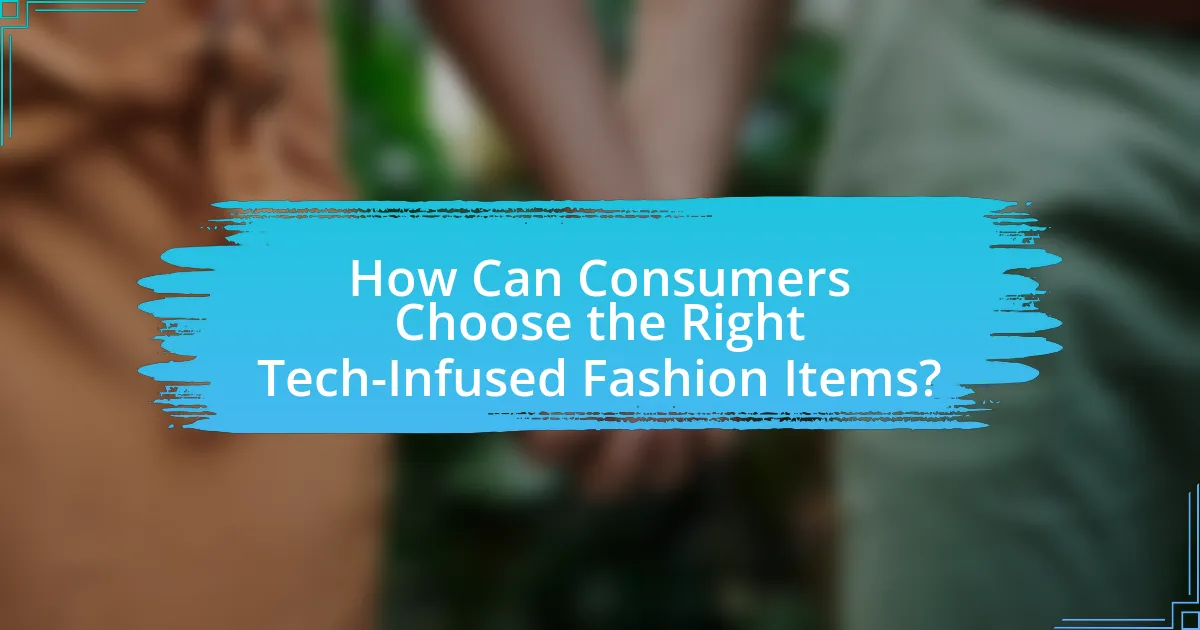
How Can Consumers Choose the Right Tech-Infused Fashion Items?
Consumers can choose the right tech-infused fashion items by evaluating functionality, style, and compatibility with their lifestyle. First, they should assess the specific technological features that enhance usability, such as fitness tracking in smartwatches or temperature control in smart clothing. Additionally, consumers must consider the aesthetic appeal of the items to ensure they align with personal style preferences. Compatibility with existing devices, like smartphones or smart home systems, is also crucial, as it ensures seamless integration. Research indicates that 70% of consumers prioritize functionality over style when selecting tech-infused fashion, highlighting the importance of practical benefits in decision-making.
What factors should be considered when selecting tech-infused accessories?
When selecting tech-infused accessories, factors such as compatibility, functionality, design, battery life, and user reviews should be considered. Compatibility ensures that the accessory works seamlessly with existing devices, while functionality addresses the specific features that enhance user experience, such as health tracking or connectivity options. Design is crucial for aesthetic appeal and comfort, as accessories should complement personal style. Battery life is important for usability, especially for devices that require frequent charging. User reviews provide insights into performance and reliability, helping to gauge overall satisfaction and potential issues.
How do personal style and functionality play a role in the selection process?
Personal style and functionality significantly influence the selection process of tech-infused fashion items by guiding consumers in choosing products that reflect their individual aesthetics while meeting practical needs. Consumers often prioritize personal style to express their identity, which can be seen in the growing trend of wearable technology that aligns with fashion preferences, such as smartwatches that come in various designs. Functionality is equally crucial, as items must provide practical benefits, such as health tracking or connectivity features, to justify their purchase. Research indicates that 70% of consumers consider both style and functionality when selecting wearable tech, highlighting the importance of these factors in the decision-making process.
What budget considerations should consumers keep in mind?
Consumers should keep in mind the total cost of ownership when budgeting for tech-infused fashion items. This includes not only the initial purchase price but also potential maintenance costs, subscription fees for software updates, and compatibility with existing devices. For example, a smart accessory may require a monthly subscription for premium features, which can add up over time. Additionally, consumers should consider the longevity and durability of the product, as higher-quality items may offer better value in the long run despite a higher upfront cost.
What are some best practices for integrating tech-infused fashion into daily life?
To effectively integrate tech-infused fashion into daily life, individuals should prioritize functionality, comfort, and style. Selecting wearable technology that enhances daily activities, such as smartwatches for fitness tracking or smart clothing that monitors health metrics, ensures practical benefits. Additionally, choosing versatile pieces that complement existing wardrobes allows for seamless incorporation into various outfits. Research indicates that 70% of consumers are more likely to adopt tech-infused fashion if it aligns with their personal style and daily needs, highlighting the importance of aesthetic appeal alongside technological features.
How can users maximize the benefits of their tech-infused accessories?
Users can maximize the benefits of their tech-infused accessories by regularly updating the associated software and utilizing all available features. Keeping software up to date ensures compatibility with the latest technology and security enhancements, which can improve functionality and user experience. Additionally, exploring and integrating features such as health tracking, notifications, and customization options can enhance the overall utility of these accessories. For instance, studies show that users who actively engage with health-tracking features on smartwatches report improved fitness outcomes, demonstrating the practical benefits of fully utilizing tech-infused accessories.
What tips can help maintain and care for these items effectively?
To maintain and care for tech-infused fashion items effectively, regularly clean the surfaces with a microfiber cloth to prevent dust and grime buildup. This method is essential as it helps preserve the functionality and appearance of electronic components embedded in the fashion items. Additionally, store these items in a cool, dry place away from direct sunlight to avoid overheating and damage to sensitive materials. Following manufacturer guidelines for charging and usage is also crucial, as improper handling can lead to battery degradation or malfunction. Regularly updating software, when applicable, ensures optimal performance and security, as outdated software can expose devices to vulnerabilities.
